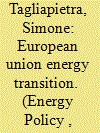| Srl | Item |
| 1 |
ID:
181470


|
|
|
|
|
| Summary/Abstract |
Annual global greenhouse-gas emissions have been rising steadily for decades and show no sign of peaking. That is, humankind is not making enough progress to exclude a possibly catastrophic climate scenario. Protecting the climate is difficult because of free-riding: emissions abatement costs are largely national but the benefits from climate stability are global. Dealing with this problem needs to be at the core of a new climate strategy. This article argues that both technological and political conditions are now ideal to establish a new climate club, in which members commit to stronger domestic climate measures and agree on the coordinated introduction of carbon border adjustment measures. On the technology side, there have been stunning clean technology cost reductions. This will underpin the climate club: as abatement costs fall, club stability can be more easily achieved. On the political side, we now see the United States, European Union and China – representing half of global greenhouse gas emissions – sharing for the first time a common climate ambition while popular support in all economies is also high for substantial climate actions. These two changes make a climate club more likely stable as the benefits from deviating from the club have diminished. A relatively weak penalty, such as carbon border adjustment measure, may then suffice for club stability. This climate club would also create incentive for other countries to join the club, thus making it a catalyst for tougher climate action worldwide.
|
|
|
|
|
|
|
|
|
|
|
|
|
|
|
|
| 2 |
ID:
166731


|
|
|
|
|
| Summary/Abstract |
Wind power represents a key component of Turkey's energy strategy. Increased investment will be required to meet Turkey's wind power target and, as such, there is a need to understand the viability of wind power projects there. The cost of capital is a crucial element in wind power investment decisions owing to the high capital intensity of wind power plants. A reduction in the cost of capital through support policies can lower overall project costs and increase investment. We estimate the cost of capital for wind power projects in Turkey using data on 138 installations that participated in the Turkish feed-in tariff scheme in 2017. Our estimates indicate an upper bound of 12% for the cost of capital. This suggests the cost of capital for wind power projects in Turkey is not higher than in south-eastern European Union countries. However, because of adverse macroeconomic conditions, the cost of Turkey's main renewable support scheme increased by 46% between 2016 and 2017 in Turkish lira terms. We argue that continued commitment to the current support schemes by the Turkish authorities is crucial for the development of the Turkish wind power sector.
|
|
|
|
|
|
|
|
|
|
|
|
|
|
|
|
| 3 |
ID:
166980


|
|
|
|
|
| Summary/Abstract |
Over the last decade, the EU has pursued a proactive climate policy and has integrated a significant amount of renewables into the energy system. These efforts have proved successful and continuing along this pathway, increasing renewables and improving energy efficiency, would not require substantial policy shifts. But the EU now needs a deeper energy transformation to decarbonise in line with the Paris agreement and to seize the economic and industrial opportunities offered by this global transformation. A full-fledged energy transition is becoming economically and technically feasible, and its cost would be similar to that of maintaining the existing system, if appropriate policies and regulations are put in place. In short, the EU could benefit from deep decarbonisation irrespective of what other economies around the world do. The transition can also be socially acceptable, if the right policies are put in place to control and mitigate the distributional effects of deeper decarbonisation. The time to act is now, as policy choices made up to 2024 will define the shape of the EU energy system by 2050. This article outlines the key priorities that, in our view, should drive the EU energy and climate policy making for the new institutional cycle 2019–2024.
|
|
|
|
|
|
|
|
|
|
|
|
|
|
|
|